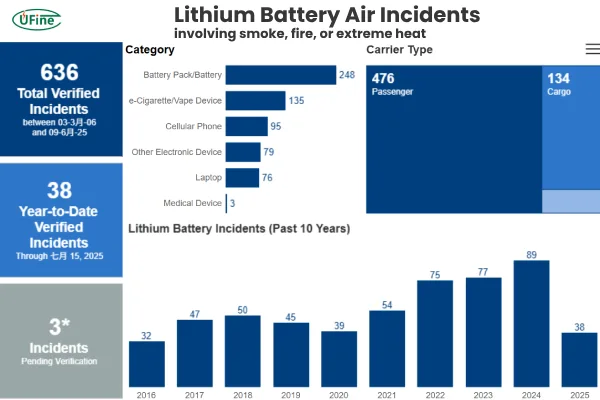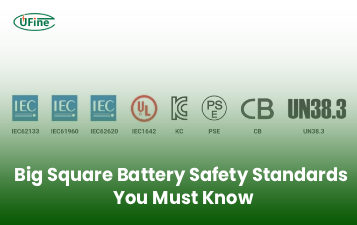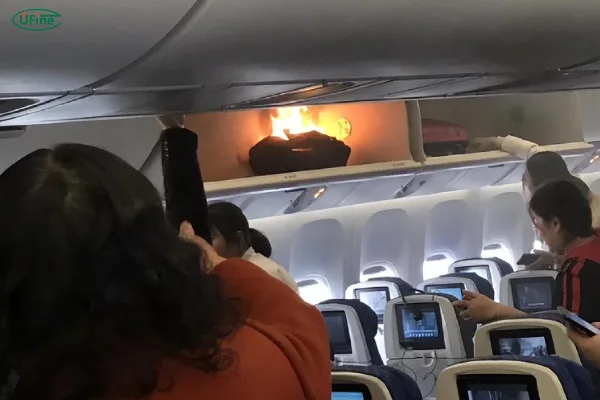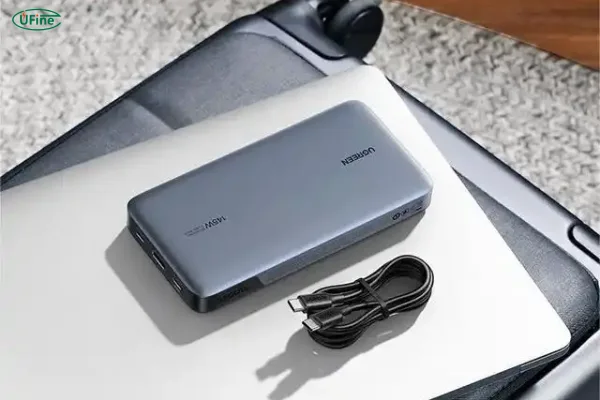
- Part 1. The problem with lithium‑ion batteries
- Part 2. Airline-specific power bank policies (2025 update)
- Part 3. How much mAh is allowed on a flight?
- Part 4. How to verify if your power bank is flight-approved?
- Part 5. Best practices for traveling with power banks
- Part 6. Consequences of exceeding power bank limits
- Part 7. FAQs
When you plan to bring a power bank on a flight, a few key questions arise:
- How much capacity is allowed?
- Where should it be packed?
- What are the safety risks?
The answer lies in understanding lithium-ion battery hazards, regulatory guidelines from agencies like the FAA and IATA, and airline-specific rules.
Part 1. The problem with lithium‑ion batteries
Why Are Power Banks Restricted on Planes?
Power banks use lithium-ion (Li-ion) or lithium-polymer (LiPo) batteries, which pose fire and explosion risks under certain conditions. The Federal Aviation Administration (FAA) and International Air Transport Association (IATA) classify them as “dangerous goods” due to:
- Thermal Runaway Risk – Overheating can cause a chain reaction, leading to fire.
- Pressure Sensitivity – Cabin pressure changes may trigger battery malfunctions.
- Physical Damage Hazards – Crushed or punctured batteries can short-circuit.
Key Incidents Leading to Stricter Regulations
- 2010 UPS Airlines Flight 6 Crash – A cargo plane carrying lithium batteries caught fire, leading to fatalities.
- 2016 Samsung Galaxy Note 7 Recall – Multiple inflight battery fires forced a global ban.
- 2023 FAA Report – Over 200 incidents involving lithium batteries on flights were recorded.
- More than 500 in-flight lithium battery incidents involving smoke, fire, or extreme heat have been recorded by the US Federal Aviation Administration (FAA) in the past two decades.

Regulatory Bodies & Their Guidelines
| Organization | Regulation | Key Rule |
|---|---|---|
| FAA (USA) | 49 CFR 175.10 | Bans power banks >100Wh in checked luggage |
| IATA (Global) | Dangerous Goods Regulations | Limits power banks to ≤100Wh (≈27,000mAh) without approval |
| EASA (Europe) | EU 2015/1998 | Requires power banks in carry-on only |
| CAAC (China) | CCAR-276 | Bans power banks >160Wh (≈43,000mAh) |
Conclusion: Airlines follow these guidelines to minimize fire risks.
Part 2. Airline-specific power bank policies (2025 update)
As of 2025, major global airlines have updated their power bank policies to reflect stricter safety regulations from aviation authorities. Below is a comprehensive, up-to-date breakdown of the latest rules from the world’s top 10 airlines, based on passenger volume and operational reach.
1. Delta Air Lines (USA)
-
Max Capacity Allowed:
-
≤100Wh (≈27,000mAh) – No approval needed
-
100–160Wh (≈43,000mAh) – Requires prior approval (72 hours before flight)
-
-
Quantity Limit:
-
2 power banks per passenger (if both ≤100Wh)
-
-
Key Restrictions:
-
No damaged or recalled models (e.g., units with swelling)
-
Must be in carry-on only (strictly prohibited in checked baggage)
-
-
2025 Update:
-
Delta now requires power banks to be in protective cases to prevent accidental activation.
-
2. American Airlines (USA)
-
Max Capacity Allowed:
-
≤100Wh – Permitted
-
100–160Wh – Banned without medical exemption
-
-
Quantity Limit:
-
1 power bank per passenger (if 20,000mAh or higher)
-
-
Key Restrictions:
-
No loose batteries (must be in original packaging or a case)
-
Must be turned off during flight (cannot charge devices mid-air)
-
-
2025 Update:
-
American Airlines now scans power banks separately at security (similar to laptops).
-
3. United Airlines (USA)
-
Max Capacity Allowed:
-
≤100Wh – Allowed
-
100–160Wh – Approval required (submit request via United’s website)
-
-
Quantity Limit:
-
Max 3 power banks (if all ≤100Wh)
-
-
Key Restrictions:
-
No power banks with removable batteries (e.g., modular designs)
-
Must be labeled with capacity (mAh/Wh)
-
-
2025 Update:
-
United now prohibits power banks from certain brands (check their banned electronics list).
-
4. Emirates (UAE)
-
Max Capacity Allowed:
-
≤160Wh (≈43,000mAh) – Approval required
-
-
Quantity Limit:
-
2 power banks per passenger (if both ≤100Wh)
-
-
Key Restrictions:
-
Must submit a safety datasheet for power banks >100Wh
-
No power banks in checked luggage (even if under limit)
-
-
2025 Update:
-
Emirates now requires a fireproof bag for power banks >100Wh.
-
5. Lufthansa (Germany)
-
Max Capacity Allowed:
-
≤100Wh – Permitted
-
100–160Wh – Banned (no exceptions)
-
-
Quantity Limit:
-
Max 2 power banks (if both ≤100Wh)
-
-
Key Restrictions:
-
Must be in original packaging (or a sealed case)
-
No charging during takeoff/landing
-
-
2025 Update:
-
Lufthansa now requires a receipt for power banks (proof of purchase).
-
6. Air France (France)
-
Max Capacity Allowed:
-
≤100Wh – Allowed
-
100–160Wh – Banned (except for medical devices)
-
-
Quantity Limit:
-
1 power bank per passenger (if >20,000mAh)
-
-
Key Restrictions:
-
Must have CE/FCC certification
-
No power banks with exposed wiring
-
-
2025 Update:
-
Air France now requires power banks to be under 30% charge when boarding.
-
7. Qatar Airways (Qatar)
-
Max Capacity Allowed:
-
≤160Wh – Approval required (submit via Qatar’s app)
-
-
Quantity Limit:
-
2 power banks (if both ≤100Wh)
-
-
Key Restrictions:
-
No power banks from unknown brands
-
Must be in carry-on only
-
-
2025 Update:
-
Qatar Airways now scans power banks with thermal imaging at security.
-
8. British Airways (UK)
-
Max Capacity Allowed:
-
≤100Wh – Permitted
-
100–160Wh – Banned
-
-
Quantity Limit:
-
Max 1 power bank per passenger (if >10,000mAh)
-
-
Key Restrictions:
-
No power banks with USB-C fast charging (due to overheating risks)
-
Must be in a protective case
-
-
2025 Update:
-
British Airways now requires power banks to be registered online before flying.
-
9. Singapore Airlines (Singapore)
-
Max Capacity Allowed:
-
≤100Wh – Allowed
-
100–160Wh – Banned
-
-
Quantity Limit:
-
Max 2 power banks (if both ≤100Wh)
-
-
Key Restrictions:
-
No power banks purchased from unauthorized sellers
-
Must be turned off during flight
-
-
2025 Update:
-
Singapore Airlines now requires a safety inspection for power banks >20,000mAh.
-
10. Cathay Pacific (Hong Kong)
-
Max Capacity Allowed:
-
≤100Wh – Permitted
-
100–160Wh – Banned
-
-
Quantity Limit:
-
1 power bank per passenger (if >10,000mAh)
-
-
Key Restrictions:
-
No power banks with wireless charging
-
Must be in original packaging
-
-
2025 Update:
-
Cathay Pacific now requires a digital declaration for power banks.
-
Pro Tip: Always check your airline’s website before flying—policies change frequently!
Part 3. How much mAh is allowed on a flight?
In general, most airlines allow each passenger to carry a maximum of two lithium-ion power banks of 100-160 Watt-hour (Wh) into the cabin.
However, most power banks on the market use the unit milliamperes per hour (mAh) to measure the battery’s capacity. So, look for ones that are no more than about 43,000 mAh to comply with most airline rules.
A single 100-Wh (27,000 mAh for a typical 3.7 volt battery) power bank is enough to charge an iPhone 13 Pro Max about three to four times.
But whether you can use them in-flight depends on the airline (and there are also exceptions for portable medical devices).
Here’s what you can bring on your carry-on:
- Korean Air: Each passenger is limited to a maximum of five 100 Wh battery packs in carry-on and checked baggage combined.
- Asiana Airlines: Spare lithium batteries and extra batteries that are 160 Wh or less must be packed in short-circuit proof packaging.
- Singapore Airlines: Customers may bring power banks with a capacity of up to 100Wh, while those between 100Wh and 160Wh require airline approval. The same rules apply on Scoot, its subsidiary, low-cost carrier.
- Cathay Pacific: Power banks must be under 100 Wh.
- Hong Kong Express: Lithium-ion batteries must not exceed 100Wh and must be individually protected to prevent short circuits.
- Qantas: No more than two spare lithium batteries exceeding 100Wh and up to 160Wh are permitted.
- Virgin Australia: Spare/loose batteries (including power banks/packs) must be in carry-on baggage only. They must be protected against short circuiting by being placed in the original retail packaging, a separate plastic bag or a protective pouch, or by insulating terminals by taping over exposed terminals.
- Air Asia: Guests may only carry power banks that do not exceed 100 watt-hours (Wh) or 20,000 milliampere-hours (mAh). Power banks between 100Wh and 160Wh require airline approval at the check-in counter.
Separately, there are no limits on carrying dry cell alkaline batteries (think Energizer Bunny batteries), according to the FAA, as long as the voltage does not exceed 12 volts and are “protected from damage.” This can be done by leaving the batteries in their retail packaging, covering battery terminals with non-metallic tape or by keeping them in an enclosed plastic bag or protective pouch.
Here’s a clear mAh-to-Wh breakdown based on typical 3.7 V power banks:
| mAh | Wh | Status |
|---|---|---|
| 10,000 mAh | 37 Wh | ✅ Allowed (no approval needed) |
| 20,000 mAh | 74 Wh | ✅ Allowed |
| 27,000 mAh | 99.9 Wh | ✅ Max allowed without approval |
| 30,000 mAh | 111 Wh | ⚠️ Needs airline approval, ≤2 units |
| 40,000 mAh | 148 Wh | ⚠️ Needs approval, ≤2 units |
| 43,000 mAh | >160 Wh | ❌ Not allowed on passenger aircraft |
Part 4. How to verify if your power bank is flight-approved?
Step 1: Check Capacity (mAh/Wh)
- Most power banks list mAh (milliampere-hours).
- Airlines measure limits in Wh (Watt-hours).
Conversion Formula: Wh=mAh×Voltage (V)/1000 (Standard power banks use 3.7V.)
Example: 20,000mAh × 3.7V ÷ 1000 = 74Wh
Step 2: Look for Safety Certifications
Approved power banks display:
✔ CE (EU Compliance)
✔ FCC (USA Compliance)
✔ RoHS (Hazardous Substance-Free)
Step 3: Inspect for Physical Damage
- Swollen? → Dispose safely (DO NOT fly with it).
- Cracked/Dented? → High risk of short-circuiting.
Step 4: Confirm Manufacturer Reputation
Avoid no-name brands—stick to Anker, RAVPower, or Xiaomi for reliable, flight-safe models.
Part 5. Best practices for traveling with power banks
✅ Do’s:
✔ Carry-On Only – Never check power banks (FAA regulation).
✔ Use Protective Cases – Prevent short circuits.
✔ Charge Before Flight – Partially charged batteries are safer.
✔ Check Airline Updates – Rules change frequently.
❌ Don’ts:
✖ Bring Damaged Units – Swollen/dented batteries are fire hazards.
✖ Exceed Quantity Limits – Most airlines allow 1–2 power banks.
✖ Ignore Local Laws – Some countries (e.g., UAE) impose fines.
Part 6. Consequences of exceeding power bank limits
What Happens at Security?
- Confiscation – TSA/airport security will seize non-compliant units.
- Additional Screening – Delays your boarding process.
- Fines (in Some Cases) – Up to $2,000 for repeat violations (FAA).
What to Do if Confiscated?
- Ask for Mailing Options – Some airports offer postal services.
- Buy a Compliant Replacement – Available at most duty-free shops.
Part 7. FAQs
1. What’s the safest power bank size for flights?
Aim for ≤27,000 mAh (100 Wh). You’ll avoid hassle and skip approval. TechRadar
2. Can I bring a 40,000 mAh power bank?
Yes—if it’s ≤160 Wh and you get airline approval (max 2 spares)
3. Why not put it in checked baggage?
The cargo hold lacks immediate fire monitoring—checked fires can go undetected until too late.
4. How do I calculate Wh?
Use: Wh = (mAh ÷ 1000) × V (usually 3.7 V).
If printed from manufacturer—use that direct rating.
5. Can damaged or recalled power banks be carried?
Absolutely not. They must be removed from your device and advertised carriers prohibit them.
6. Are there airline-specific visibility rules?
Yes—Air Busan, Southwest, EVA Air, and many Asian carriers require visible storage during use.
7. What if I have multiple small power banks?
No limit for ≤100 Wh units, but follow rules for packaging and cable protection.
Related Tags:
More Articles

Big Square Battery Safety Standards You Must Know
Learn key safety standards for big square batteries to avoid fire risks, shipping delays, and compliance issues in EV, industrial, and energy storage projects.
Big Square Battery Applications in Solar & Industrial Equipment
Big square batteries deliver high capacity, stable output, and long life for solar, industrial, and backup power. Explore key uses and advantages.
Big Square Battery vs Cylindrical Battery: Complete 2025 Guide for EVs, ESS & Industrial Devices
Choosing the right battery is key for designers and engineers. Compare big square vs cylindrical batteries to find the best fit for your application.
How to Choose the Right Big Square Battery for Your Device?
If you’re choosing a big square battery for EVs, solar, or mobility devices, this guide helps you pick the right solution for real-world needs.
Big Square Battery Complete Guide: Types, Uses & Buying Tips
If you are choosing a big square lithium battery for EVs, solar, RVs, or AGVs, this guide helps you select the right NMC, LFP, or LTO solution with examples.




